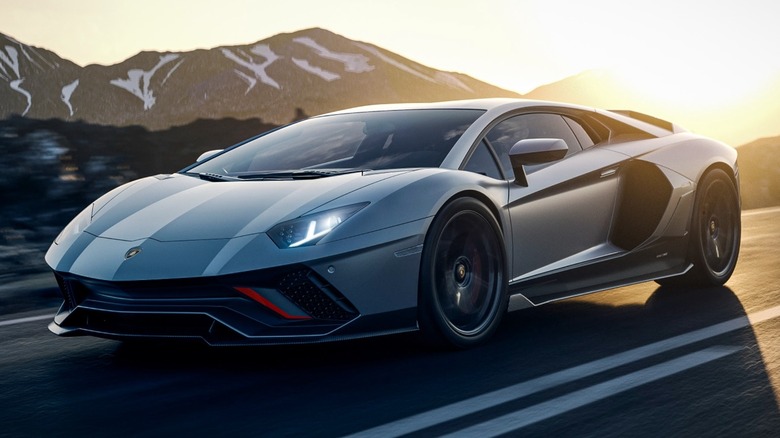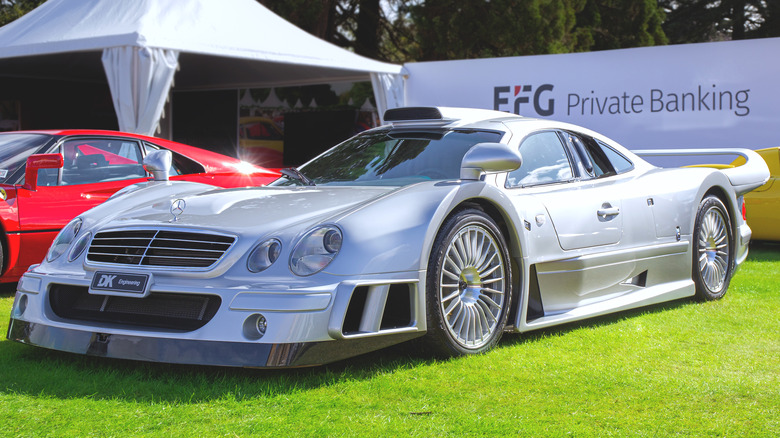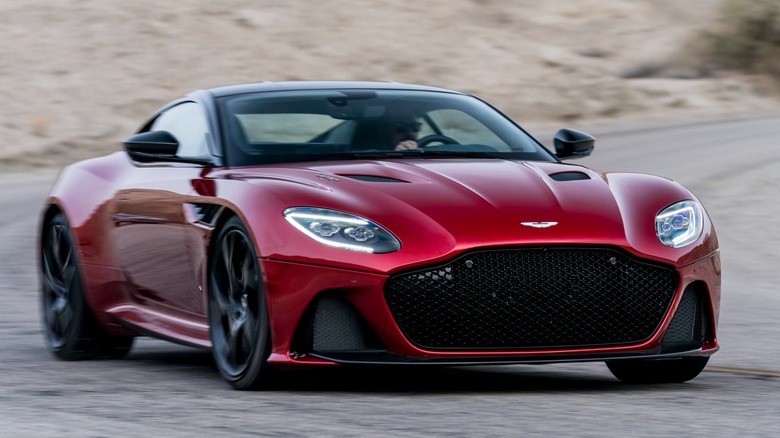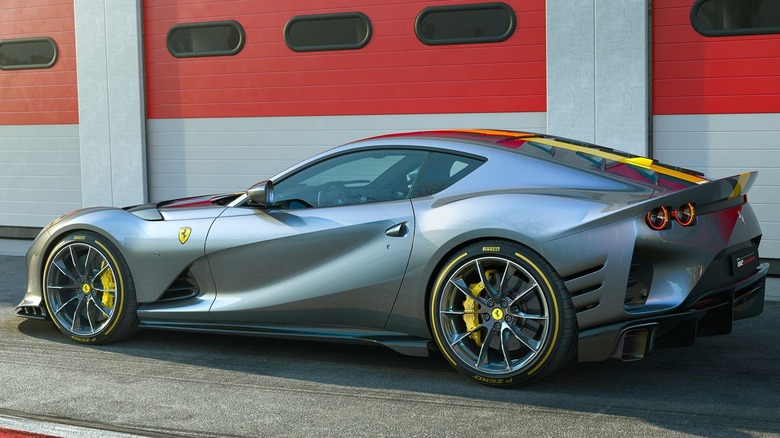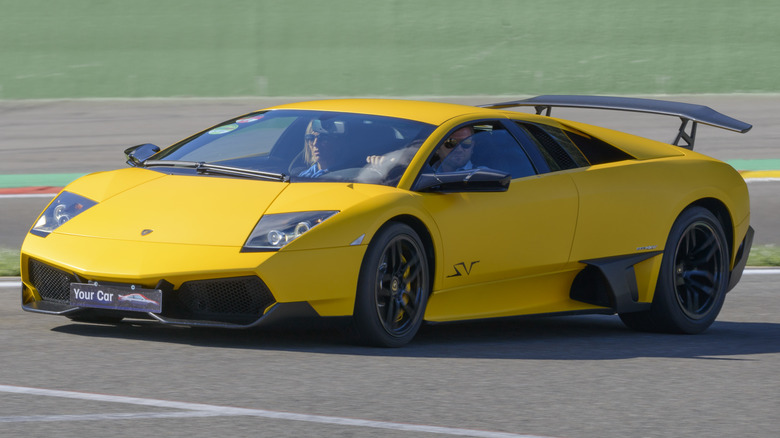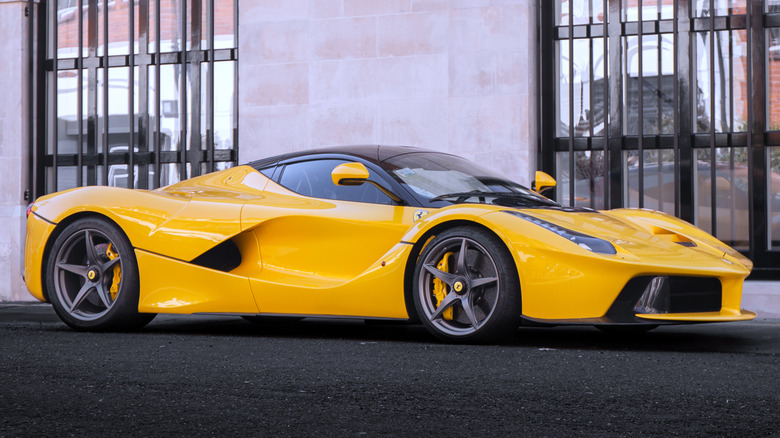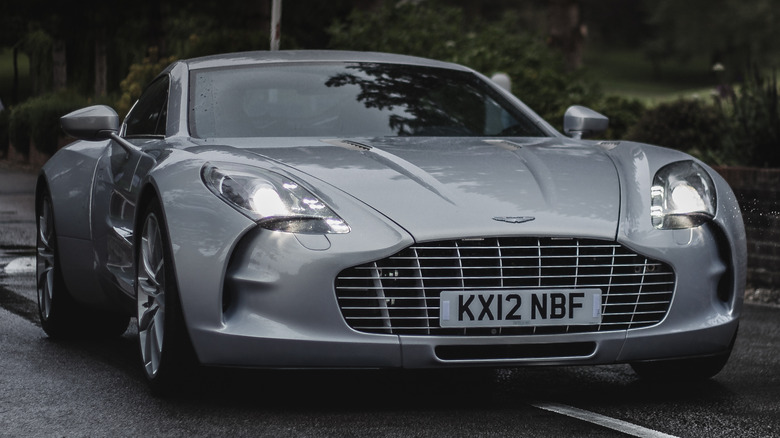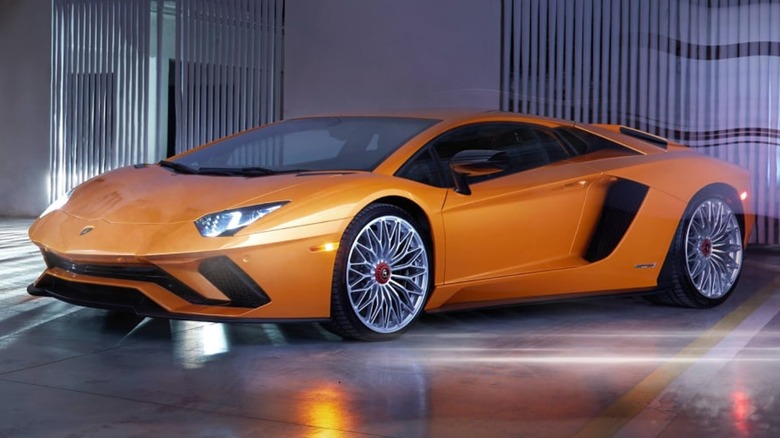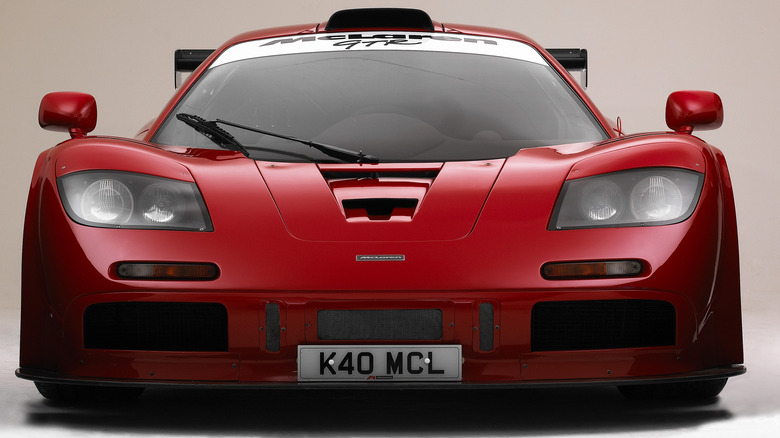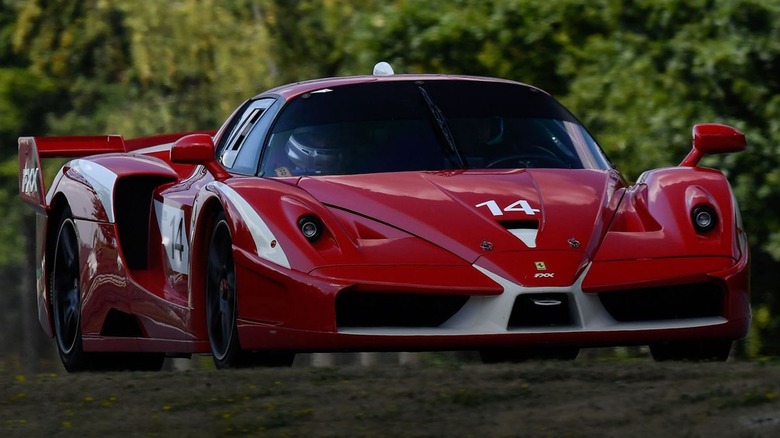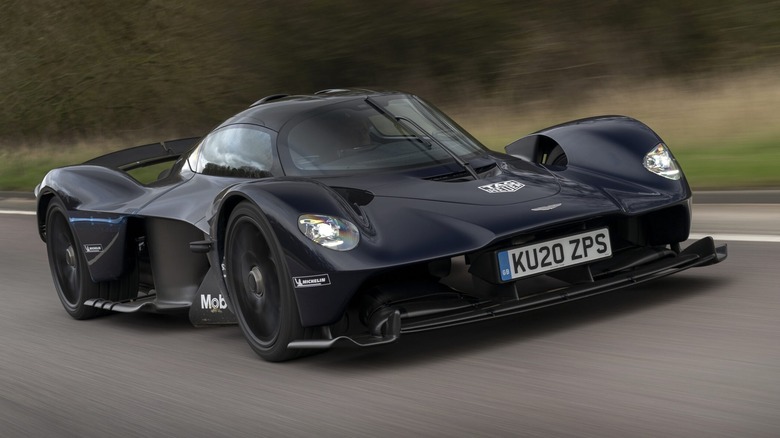10 Of The Fastest Cars Built With A V12 Engine
V12 engines are among the few powerplant configurations that inspire awe. These majestic powerplants are the pinnacle of refinement and performance for some automakers. Renowned for their throaty exhaust notes, V12s deliver power in a smooth and exhilarating manner. Thanks to their architecture, they have a more balanced firing order with the cylinders igniting more frequently throughout the engine cycle.
In addition, their larger size allows them to naturally produce power without relying on high RPMs, which creates a feeling of boundless thrust that leaves most engines in the dust. Historically, these engines have been the domain of high-performance and luxury car manufacturers. Nowadays, V12 engines are still present in high-performance vehicles, producing bonkers performance, be it in their naturally aspirated form or with the help of hybridization or forced induction. Below, we delve into the world of the fastest machines powered by the mighty V12, each with a staggering top speed of over 200 mph.
Mercedes-Benz CLK GTR – 205 MPH
Mercedes introduced the CLK GTR in 1997, a supercar created by Mercedes-AMG, in a record time of only 128 days. While the CLK GTR shared its name with the road-going Mercedes-Benz CLK, there was little resemblance, apart from using the same headlights, grille, and taillights. To create the CLK GTR in such a short time, the AMG team bought a secondhand McLaren F1, replacing its BMW-sourced engine with the CLK GTR V12 for testing. This enabled the team to build an iconic supercar boasting modern technologies like carbon fiber body panels and a central carbon fiber tub. These materials helped give the CLK GTR excellent rigidity and low weight.
At the rear sat a Mercedes M297 engine, a 6.0-liter V12 derived from the M120 in the S and SL class vehicles. This engine produced 584 hp and 516 lb-ft of torque, sending it to the rear wheels through a six-speed sequential transaxle. With the powertrain, the Mercedes-Benz CLK GTR would sprint from 0 to 60 mph in just 3.8 seconds and reach a 205-mph top speed. The CLK GTR had excellent components, including adjustable front and rear suspension and six-piston brakes with carbon composite rotors.
Aston Martin DBS Superleggera – 211 MPH
Aston Martin introduced the DBS Superleggera in 2018, a thoroughbred super grand tourer with carbon fiber body panels and a mighty twin-turbocharged 5.2-liter V12 engine. This powertrain produces 715 hp and 664 lb-ft of torque. It pairs with a ZF eight-speed automatic transmission, sending power to the rear wheels, helping the DBS Superleggera dart from 0 to 62 mph in 3.4 seconds and reach a 211-mph top speed. Aston Martin sets the engine low and back in the chassis, helping optimize weight distribution and the center of gravity.
The chassis is made from a bonded aluminum structure and features forged double wishbones at the front and a multi-link system at the rear. In addition, the DBS Superleggera boasts innovative aerodynamic concepts, including an F1-inspired double diffuser, which generates 397 pounds of downforce at VMAX, the highest figure in a production Aston Martin. The DBS Superleggera promises predictable, precise, and exploitable handling thanks to torque vectoring and a mechanical limited-slip differential.
Since the DBS Superleggera is a flagship super GT, it boasts a high level of craftsmanship, offering buyers an extensive scope for personalization. Aston Martin provides an array of standard features, including sports plus performance seats, leather and Alcantara upholstery, and an 8.0-inch infotainment screen with navigation. While the DBS Superleggera is an impressive super GT, Aston Martin offers something even more powerful: the stunning DBS 770 Ultimate. They share the powertrain, but the 770 Ultimate improves performance to 759 hp and 664 lb-ft of torque. Despite its power increase, Aston Martin limits its top speed to 211 mph.
Ferrari 812 Competizione – 211 MPH
The Ferrari 812 Competizione is a wild update to the already crazy 812 Superfast. A front mid-engine supercar using the same foundation, it epitomizes Ferrari's decades of automotive experience, perfectly marrying performance and functionality. The 812 Competizione boasts a 6.5 liter naturally aspirated V12 engine with 819 hp and 512 lb-ft of torque. This mighty powertrain enables the 812 Competizione to scamper from 0 to 62 mph in 2.85 seconds and reach a 211-mph top speed.
Ferrari offers two versions of the 812 Competizione, a coupe and a roadster called the Competizione A. Both versions boast a slightly higher redline over the 812 Superfast, revving up to 9,500 rpm. To achieve this, the 812 Competizione's engine has a lighter crankshaft, titanium connecting rods, diamond-like carbon coating on some surfaces, and a new cylinder head. It also boasts a redesigned oil tank, to better handle lateral and longitudinal forces. Ferrari pairs the engine with a seven-speed dual-clutch automatic, sending power to the rear wheels.
To help increase the 812 Competizione's downforce, Ferrari adds a revised rear spoiler profile and a new rear diffuser. The Competizione also does away with the rear window in favor of a panel with riblike protrusions. This panel also helps disrupt airflow, thus balancing the downforce at the rear of the 812 Competizione. With the engine up front, Ferrari uses a retuned rear-wheel steering system, which helps keep the Competizione stable. This revised rear-wheel steering system can independently mitigate understeer or stabilize the car without steering wheel inputs.
Lamborghini Murcielago SV – 213 HP
Lamborghini unveiled the Murcielago at the 2001 Frankfurt Motor Show. This marked the first Lamborghini vehicle of the 21st century to use the brand's legendary V12 engine, which was used in Lamborghini's most iconic models for almost six decades. The initial models of the Murcielago produced only 572 hp from the V12. However, the Superveloce (SV), introduced in 2009, upped the performance of the naturally aspirated 6.5-liter V12 to 661 hp. This enabled it to dash from 0 to 62 mph in 3.2 seconds and reach a 213-mph top speed. This upgraded version of the Murcielago showcased Lamborghini's exceptional skills thanks to its use of advanced materials like carbon fiber, which helped lower its overall weight.
In addition, Lamborghini also made some tweaks to the Murcielago SV's interior, fitting it with sturdy, light carbon fiber seats, which safely restrained the driver even on the track. In its lifetime, the Murcielago was featured in multiple movies, with one of its most famous roles being in "Batman Begins," a 2005 film where the Murcielago was the personal vehicle for Bruce Wayne (Christian Bale). The Murcielago also had an extraordinary career in video games, including "Drive Club," "Forza Horizon," and the "Gran Turismo" franchise.
Ferrari LaFerrari – 217 MPH
Ferrari unveiled the LaFerrari at the 2013 Geneva Motor Show. This was the definitive Ferrari of its era, rivaling other hybrid supercars like the McLaren P1 and Porsche 918 Spyder. The LaFerrari was a limited-edition supercar available in two configurations, a coupe and a convertible, also known as the roadster. The LaFerrari Aperta offered enthusiasts an open-air experience while maintaining the automotive DNA of the LaFerrari. Unlike most Ferrari supercars, the LaFerrari was a hybrid, boasting a mighty, naturally aspirated 6.3-liter V12 engine with 798 hp and 516 lb-ft of torque.
At the time, this was the most powerful V12 engine, and it was supplemented by a KERS unit, upping the total performance to 950 hp and 664 lb-ft of torque. Ferrari paired the LaFerrari's engine with a seven-speed dual-clutch automatic, enabling the LaFerrari to dash from 0 to 60 mph in 2.4 seconds and reach a 217-mph top speed. Using the hybrid powertrain enabled the LaFerrari to enjoy the best of both worlds. It had the highest power output of any Ferrari at the time — a distinction it kept until the plug-in hybrid SF90 supercar was released — and boasted a 40% drop in fuel consumption compared to other V12-powered Ferraris.
The F1-derived KERS system made the LaFerrari a trackable car, giving it instant throttle response. Fortunately, this wasn't the only high-tech innovation in the LaFerrari. Additional features included a lightweight carbon fiber chassis and active aero, which offered greater downforce and helped improve braking and cornering.
Aston Martin One-77 – 220 MPH
The Aston Martin One-77 was one of the most exclusive models in its era, with only 77 examples made. Aston Martin first introduced the One-77 at the 2008 Paris Motor Show, giving the world a glimpse of its new hypercar. At the 2009 Geneva Motor Show, Aston Martin finally revealed the One-77, including its chassis and powertrain. The beating heart of the One-77 was a 7.3-liter V12 engine, producing 750 hp and 553 lb-ft of torque. This engine paired with a six-speed automated manual transmission, sending power to the rear wheels.
The monstrous powertrain helped make this the fastest Aston Martin yet, managing a quick 0 to 60 mph run of 3.7 seconds and a top speed of 220 mph. Like most modern Aston Martins, the One-77 featured a lightweight, rigid carbon fiber monocoque and handcrafted aluminum bodyshell. While Aston Martin ended production of the One-77 in 2012, its beating heart lives in on the Aston Martin Victor, a special edition with a melodic soundtrack and astounding performance.
Lamborghini Aventador Ultimae – 221 MPH
Lamborghini introduced the Aventador in 2011, giving enthusiasts a supercar with new technologies and a mighty V12 powerplant. The Ultimae is the brand's beastly send-off for the Aventador, concentrating on the purest features of previous editions for the perfect finale. Like previous models, the Ultimae boasts a carbon fiber monocoque, which offers unprecedented rigidity and weight reduction.
It also features a mighty 6.5-liter naturally aspirated V12 engine, producing 769 hp and 531 lb-ft of torque. This version of the V12 engine is the most powerful production naturally aspirated V12 in Lamborghini history. That's thanks to Lamborghini's use of titanium intake valves, helping deliver performance without compromise. Lamborghini pairs the V12 with a seven-speed automated manual transmission, sending power to all four wheels. The robotized transmission promises lightning-quick gear shifts while maintaining low weight and a smaller size than a manual transmission. This powertrain enables the Aventador Ultimae to dash from 0 to 62 mph in 2.8 seconds and reach a 221-mph top speed.
In addition to the iconic V12 engine, the Ultimae features a rear steering system and magnetorheological front and rear shock absorbers. These systems help it deliver dynamic performance at low and high speeds. The Ultimae also features four driving modes: Strada, Sport, Corsa, and Ego. They ensure complete control of the transmission, engine, steering, traction, stability control, and suspension, helping deliver a unique driving experience.
McLaren F1 – 240 MPH
The McLaren F1 was the brand's first production car, debuting in 1992. McLaren only produced 106 units, boasting a naturally aspirated 6.1-liter V12 engine with 612 hp and 479 lb-ft of torque. With all this power, McLaren had to line the engine bay with a pure gold thermal heat shield to prevent the engine from overheating. This resulted in one of the most powerful supercars of its day, managing a blistering 0 to 60 mph run of 3.2 seconds and a record-breaking top speed of 240 mph. Decades later, the McLaren F1 is still among the fastest vehicles in the world, thanks to most automakers limiting their vehicle's top speeds.
When developing the F1, McLaren set out to make a Formula 1 car adapted for the road. This led to the use of Formula 1 technology, which had never been applied before on a road-going vehicle. Among the key features of the F1 were the lightweight carbon fiber chassis and the three-seat interior. While most mid-engine supercars of the time featured a rear wing, the McLaren F1 didn't. This further pushed its external envelope, optimizing it for aerodynamic performance.
Thanks to McLaren's Formula 1 specialists, the F1 was the first production car to benefit from moving-ground wind tunnels, which mimicked the interaction between a moving car and the road — most cars used less accurate fixed-floor tunnels at the time. Armed with more accurate information, engineers were able to utilize the ground effect by directing airflow beneath the F1 to generate powerful, stabilizing downforce.
Ferrari FXX Evoluzione – 249 MPH
The FXX was a special Ferrari track car introduced in 2005. Ferrari only produced 30 examples of the FXX, with the final version going to Michael Schumacher, a Scuderia Ferrari F1 driver. This would later be the basis for the Ferrari FXX Evoluzione (Evo), which Ferrari introduced in 2007, offering a wider range of improvements and developments over its predecessor. Among the notable changes was a power increase, enabling the 6.2 liter naturally aspirated engine to produce 789 hp and 509 lb-ft of torque.
The FXX Evo also featured a better traction control system with nine different settings. These enabled the driver to fine-tune the car by adjusting its behavior from corner to corner, and resulting in a less intrusive traction control system that could quickly adapt to an individual driver's style. These changes helped the FXX Evo reach a 249-mph top speed, making it one of the fastest Ferraris ever produced. Ferrari also added two cameras, working with the existing rear-facing camera to give the driver optimal visibility through the screens in the passenger compartment.
Fortunately, Ferrari has continued with the XX program, giving enthusiasts track-capable road cars like the modern SF90 XX Stradale and SF90 XX Spider. While these vehicles don't use the iconic V12 engine, they boast improvements to the powertrain and aerodynamics, helping make them more responsive on the road and track.
Aston Martin Valkyrie – 250 MPH
The Aston Martin Valkyrie is the brand's road race car, resembling an IMSA GTP. This ultra-performance hypercar boasts a hybrid powertrain that combines a 6.5-liter naturally aspirated Cosworth RA V12 with a battery electric system from Rimac. On its own, the V12 produces 986 hp and 546 lb-ft of torque. That's already more performance than the LaFerrari, 918 Spyder, and McLaren P1, and the additional battery electric system helps up the Valkyrie's output to 1,144 hp and 664 lb-ft of torque.
To develop the Valkyrie, Aston Martin teamed up with several brands, including Cosworth, to create an engine with a high-revving character. The Valkyrie also has some Formula 1 DNA, thanks to Red Bull Advanced Technologies, which helped make it one of the best-performing cars. All this results in the Valkyrie's ability to sprint from 0 to 60 mph in just 2.5 seconds and reach an unrestricted top speed of 250 mph.
Surprisingly, Aston Martin also offers a track-only version called the Valkyrie AMR Pro. This track car uses a unique version of the Valkyrie chassis and an aggressive aerodynamic package, which helps it comfortably deliver twice the amount of downforce. In addition, the AMR Pro does away with the battery pack, retaining only the V12 engine to minimize weight and achieve the fastest lap times. Thanks to these changes, the AMR Pro can quickly lap the 8.5 mile 24H Le Mans circuit in 3 minutes 20 seconds — a performance aimed at challenging LMP1 cars for the win.
